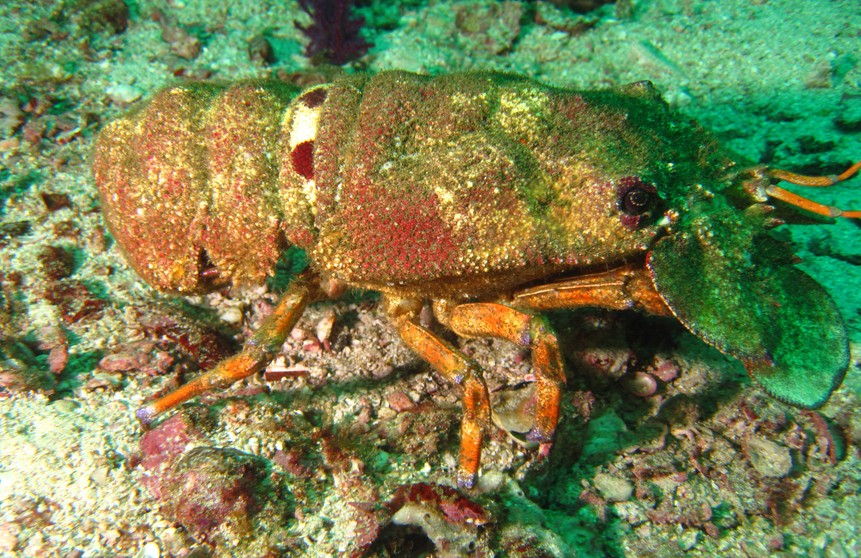THENUS ORIENTALIS - (LUND, 1793)
T. orientalis is known by a number of common names. The United Nations' Food and Agriculture Organization prefers the name flathead lobster, while the official Australian name is Bay lobster. In Australia, it is more widely known as the Moreton Bay bug after Moreton Bay, a location in Queensland. In Singapore, both the flathead lobster and true crayfish are confusingly called crayfish. They are popularly used in many Singaporean dishes.
T. orientalis has a strongly depressed body, and grows to a maximum body length of 25 centimetres (9.8 in), or a carapace length of 8 cm (3.1 in).
Thenus orientalis has an Indo-West Pacific distribution, ranging from the east coast of Africa (southern Red Sea to Natal) to China, southern Japan, the Philippines and along the northern coast of Australia from Western Australia to Queensland. They are also caught on a small scale off the shores of Malaysia and Singapore.
Diagnosis
Body strongly depressed. Lateral margin of the carapace with only the cervical incision. No teeth on the lateral margin of the carapace, apart from the anterolateral and postcervical. Orbits on the anterolateral angle of the carapace. Exopod of third and first maxilliped without a flagellum; the flagellum of the second maxilliped transformed into a single laminate segment. Fifth leg of female without a chela.
Type
Type locality of S. orientalis: "Fra Ostindien og China". Lund's material consisted of a specimen from Tranquebar, India, and one from China, so that both are syntypes; also a syntype is the specimen figured on pl. 2 fig. D in Rumphius' (1705) Amboinsche Rariteitkamer, this specimen not necessarily comes from Amboina, as the figure was made in Holland after a specimen of unknown locality and subsequently added to Rumphius' manuscript, it most likely originated from Indonesia. One of Lund's two specimens is in UZM, it is preserved in alcohol, its condition is reasonable; the second specimen is lost. The third syntype specimen formed part of the collection of Henricus d'Acquet, burgomaster of Delft, The Netherlands, this collection was sold publicly in 1708, the fate of the specimen of Thenus is unknown.
Type locality of Thenus indicus: "Habitat in mari Indico". Holotype in BM, no 107 a 54, dry, conditionfair (it is not fully certain that this is the holotype).
Geographical Distribution
Indo-West Pacific region: from the east coast of Africa (southern Red Sea to Natal) to China, southern Japan, the Philippines and tropical Australia (Western Australia to Queensland).
Habitat and Biology
Depth range from 8 to 70 m (exceptionally in 100 m), usually between 10 and 50 m; on soft substrate: sand or mud, or a mixture of the two, sometimes with shells or gravel.
Size
Maximum total body length about 25 cm; maximum carapace length about 8 cm.
Interest to Fisheries
The species often appears as a by- catch in the nets of trawlers and is edible. It is also reportedly taken by divers although there is no specialized fishery for it. Specimens caught in the sixties in the southern Red Sea by Israeli trawlers were frozen and sold in Israel. Experimental fishing undertaken in 1975 to 1976 off the coast of East Africa (Kenya to Mozambique) and elsewhere in the Western Indian Ocean was not promising for this species (up to 30 specimens per hour). Longhurst (1970: 286) mentioned that it is "caught in the Gulf of Thailand, and on a small scale off Malaysia and Singapore". In Queensland, the shrimp fishery lands Thenus as a bycatch where it ranks above Ibacus as a food item (Grant, 1978: 685). It is also offered for sale in Sydney markets. In Taiwan, this species is found in markets year-round but is most abundant from March to August, and is marketed together with Ibacus ciliatus and I. novemdentatus (Chang, 1965: 47) In the Philippines it is priced lower than spiny lobsters (Motoh and Kuronuma, 1980: 58). Davidson (1977: 141) remarked of this species: "The meat of the slipper lobster is not quite up to the standard of good prawns or spiny lobsters, but is nonetheless well worth eating". Marketed locally either fresh or frozen.
